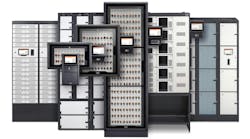In this edition of Voices of the Industry, Byron Miller, Senior Vice President of Operations at FORTRUST, shares his insights on the key components to look for when choosing a DCIM solution.
Byron Miller, Sr. VP of Operations at FORTRUST
In today’s data center sector, infrastructure management is more important than ever. IT configurations and environments are becoming increasingly complex, and maintaining oversight across the range of equpiment and ensuring that client needs are addressed is more difficult than ever. With a Data Center Infrastructure Management (DCIM) solution in place, however, these and many other obstacles can be mitigated while improving the overall operations of the data center.
However, no two DCIM solutions are the same. Data center operators must understand the key components to look for within a system to select the one that best suits their organization. In this spirit, let’s examine what exactly is needed for effective DCIM.
Why is DCIM essential?
Before we dive into the main considerations, it’s imperative for data center managers to understand why this technology is needed in the first place.
Data center environments have considerably evolved recently to include not only emerging technologies, but legacy systems that have been in place for a number of years. As clients increasingly adjust their enterprise and colocated data center environments, these spaces, whether single occupant or multi-tenant, will only become more complex.
“It is not uncommon for modern data centers to have a varied mix of entry-level to enterprise-class servers running various operating systems, firewalls, gateways, switches, routers, environmental monitoring solutions, building automation systems and uninterruptible power supplies to name a few,” Lantronix pointed out. In order to effectively manage these increasingly complicated environments, managers must be able to access the latest information from wherever they may be operating. A remote monitoring solution enables this type of access, ensuring facility operators can keep a watchful eye on all equipment and conditions even when they have left the data center.
“Companies suffering just 5.5 hours of downtime could stand to lose almost $4 million in productivity and profits.”
In addition, DCIM isn’t just about oversight and management, it’s also imperative to prevent costly outages. Infonetics Research found that Fortune 100 and Fortune 500 companies suffering just 5.5 hours of downtime could stand to lose almost $4 million in productivity and profits. For this reason and many others, it is in the data center operator’s best interest to prevent these instances from happening in the first place. Armed with a DCIM solution, facility managers can be aware of problems before they lead to outages, and can work to mitigate risk accordingly.
What should a DCIM solution include?
When it comes to DCIM, there are several technologies on the market that can be integrated to create a unified solution. However, operations managers must ensure that they are selecting those with the proper credentials and capabilities to meet the unique needs of their facilities. No two data centers are the same, and thus, different facilities will have different requirements when it comes to their DCIM.
That being said, there are a few staple considerations that can be made across the board. Let’s take a look at some of the components decision-makers should examine when choosing a DCIM solution:
- Can it be accessed from a variety of locations and devices? DCIM would not be truly remote if users can’t connect with the solution from outside the data center. Managers should also check that the platform will display properly on different device screens so that smartphones and tablets can also be used to access the solution as opposed to a traditional desktop. It should also provide alerting, escalation features and the ability for the user to determine and create thresholds for each along with any number of monitored parameters and conditions.
- Is it scalable? A DCIM solution should be able to grow alongside the data center. This means that any time the infrastructure expands, a new client establishes an environment or an existing customer adds equipment, the DCIM tool can grow to include these additions as well. The DCIM system should also be able to do historical trending to enable predictive analytics.
- Is it secure? Facility operators should also check the security of the DCIM solution to ensure that only approved users can access the platform. The solution should have protection measures in place, including multiple authentication credentials, to keep out the unwanted eyes and activities of hackers.
- What does the DCIM solution monitor? Another key consideration to make is what will be included in the monitoring capabilities of the system. As noted previously, different facilities will have a variety of requirements here. However, main components including the data center’s entire critical systems infrastructure including power, cooling, and fire/life safety resources should be included here. Additionally, it should be able to provide reporting and graphical tools for specific parameters.
Byron Miller is the Senior Vice President of Operations at FORTRUST, a colocation provider that offers a DCIM service called COLOVIEW, which gives clients access to data about their colocated IT environment’s power, cooling, relative humidity and temperature statistics.


